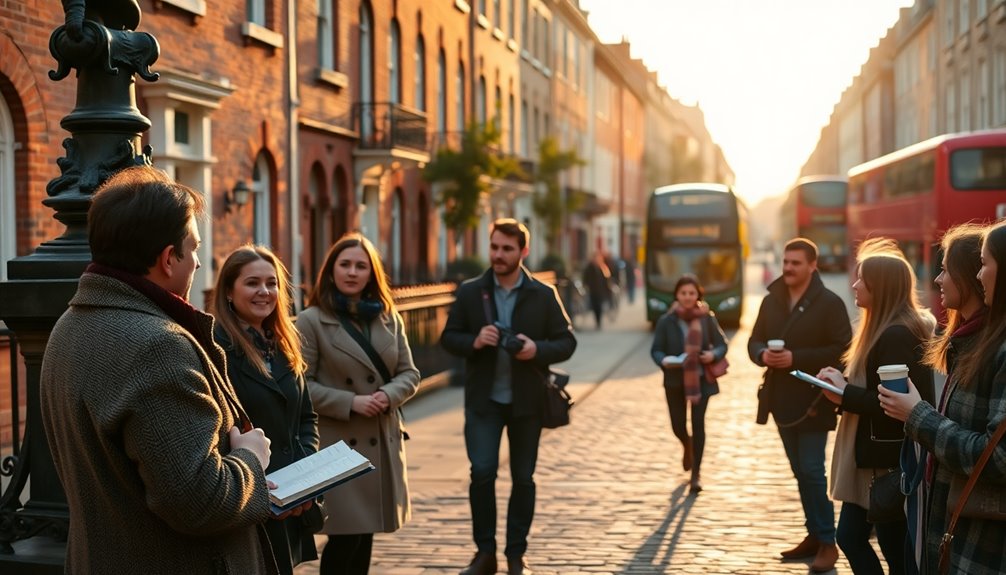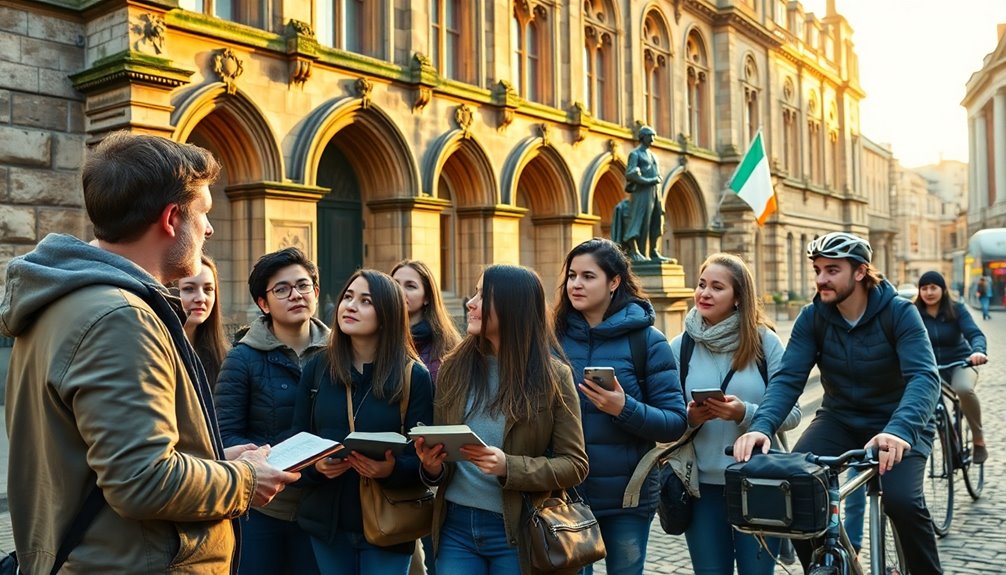
You’ll learn English in class and practice it on guided Irish history tours that link words to places and stories, so vocabulary and confidence grow naturally. Short lectures, small-group walks, and living-history moments give you contexts for everyday phrases, idioms, and polite questions. You’ll meet locals, try conversational repairs, and build memory through vivid scenes like Dublin Castle or coastal cliffs. Practical tips help you plan for weather and access, and there’s more guidance ahead if you want it.
Why Combine Language Learning With Historical Site Visits

When you learn a language amid the stones and stories that shaped it, words gain weight and meaning — vocabulary isn’t just memorized, it’s wired to places, people, and moments in time. You’ll find that language immersion paired with historical site visits calms the anxiety of speaking because context holds your hand; a ruined abbey, a market square, or a classroom becomes a predictable stage where phrases fit naturally. You’ll notice cultural enrichment unfolding quietly: gestures, local expressions, rhythms of conversation that textbooks can’t replicate. This approach keeps you safe emotionally and pedagogically — mistakes become shared observations, not failures, and you can test language in controlled, guided settings. You’ll build memory by association, linking a word to a vista or a story, which steadies recall under pressure. In short, combining site visits with lessons makes learning tangible, respectful, and sustainable, so you progress with confidence and a deeper sense of belonging.
Top Irish History Tours to Join During Your Course
Although you’ll find history woven into every lane and coastline in Ireland, these carefully chosen tours turn that tapestry into a clear, living lesson—each one pairs a vivid story with places where language and history collide so you can practice speaking while you’re standing in the scene. Start in Dublin Castle, where guided walks explain courts, state rooms, and the city’s layered past; you’ll be close to central transport and well-lit areas, so you can feel secure while asking questions. Head west to the Cliffs Moher for a breath-taking coastal narrative; stick to marked paths, follow your guide, and use the viewing platforms to describe the landscape aloud. Choose small-group historical walking tours, living-history reenactments, or community-led village excursions — each offers safe, structured conversation practice amid authentic settings. Book with vetted operators, check accessibility and weather plans, and you’ll leave each tour more confident in both English and your footing in Ireland’s stories.
How Historical Context Enhances English Conversation Skills
Moving from guided routes and landmark stories to the way those scenes shape your speech, historical context gives your conversations depth and direction. When you listen to local historical narratives on a tour, you pick up not just facts but tone, pacing, and the gentle cadences that make expressions feel safe and familiar. That background lets you respond with confidence, choosing words that match the moment — respectful on solemn sites, lively in taverns where stories are traded. Language immersion in real settings helps you practice repairs, questions, and small talk with cultural cues intact, so you’ll avoid awkwardness and feel secure. As you reflect on events and place them in conversation, you’re learning to frame opinions with care, to ask empathetic follow-ups, and to use idioms appropriately. This mindful approach strengthens fluency and interpersonal ease, giving you conversation skills rooted in context rather than isolated drills.
Planning Your Week: Balancing Classes and Excursions
As you map out your week, let practicality guide you so the rhythm of classes and excursions feels purposeful rather than rushed. You’ll want to align class schedules with quieter mornings for study and afternoons reserved for guided outings, so energy and attention stay steady. Think of each day as a deliberate balance: classroom practice that builds confidence, followed by a paced historical walk that deepens context.
Keep safety front of mind—confirm meeting points, transport times, and contact details before you step out. Check excursion logistics in advance: route length, expected terrain, and weather contingencies; that way you won’t be surprised or pressed for time. Build small recovery windows between activities to reflect, rest, and review notes.
When you plan this way, learning feels anchored and secure. You’ll move through the week with calm purpose, soaking up language and history without sacrificing wellbeing or focus.
Practical Tips for Making the Most of Guided Walks
Once your week is mapped out, guided walks become the living layer that ties classroom lessons to real streets and stories—so think ahead about how to engage actively rather than just observe. You’ll want to arrive early, dress for variable weather, and carry a charged phone and small torch so you feel secure at dusk. Practice guided tour etiquette: mute phones, listen when others speak, and ask concise questions that deepen context. Use immersive learning techniques by noting vocabulary, sketching maps, or recording short voice memos to revisit later. Stay close to the group, follow the guide’s directions, and flag any mobility concerns before you start. Reflect aloud with classmates afterward to reinforce language and memory, but respect nearby residents and private spaces while you do. If a route feels unsafe or unclear, tell the guide calmly — safety and curiosity can coexist, and thoughtful preparation helps you absorb history without compromising well-being.
Local Cultural Experiences to Pair With Museum Visits

When you step out of a museum, don’t let the experience end at the exit—you can amplify what you’ve learned by pairing exhibits with nearby cultural stops that bring history to life. You’ll find quiet tea rooms, artisan workshops, and preserved neighborhoods where the textures and smells echo the stories you’ve just seen. Choose experiences that favor cultural immersion and interactive storytelling: a guided craft session where a maker explains traditional techniques, or a small-group oral-history listening where locals share memories tied to objects in the galleries. Move slowly, reflect at benches or in public squares, and let sensory details—voices, fabrics, recipes—anchor your learning. Opt for reputable, small-scale venues with clear information and predictable schedules so you feel secure. You don’t need to race; a carefully chosen stop that complements an exhibit will deepen vocabulary and historical nuance, helping you connect English study to lived Irish culture in a mindful, memorable way.
Safety, Accessibility, and Weather Considerations on Tours
Pairing museum visits with nearby cultural stops can leave you wanting to linger longer, but before you set out to explore tea rooms and workshops, think about safety, accessibility, and weather so your plans actually work. You’ll want to check venue safety protocols — entrances, emergency exits, and any visitor limits — so you’re not caught off guard. Consider mobility needs: cobbled streets, stairs without lifts, and uneven paths can change a half-day into a strain unless you plan routes and rest stops. Pack for Irish moods: a light waterproof, compact umbrella, and layered clothing signal practical weather preparedness. Keep contacts handy — tour leader, local clinic, accommodation — and share your itinerary with someone you trust. Move at a pace that lets you enjoy language learning without risking fatigue. Thoughtful preparation keeps curiosity free to roam; when you respect safety and accessibility, the landscape, history, and English practice all feel within reach.
Meeting Locals: Using History Tours to Practice Authentic English
Although guided walks give you phrases and practice, the real boost comes from stopping to chat with stallholders, museum volunteers, or the person you find leaning on a churchyard wall; these brief, unscripted exchanges teach idioms, timing, and the warmth of conversational English in ways classroom drills can’t. You’ll be gentle and observant, choosing safe moments to ask about a craft, a plaque, or a memory tied to a street. That curiosity opens doors to community engagement and authentic pronunciation cues, while locals often welcome respectful interest as cultural exchange. Listen for pauses, humor, and the rhythm of everyday speech, and mirror them subtly to build rapport. Keep interactions short at first, watch body language, and accept a polite decline without pressure. Over time, those small, secure conversations become confidence-building bridges between textbook rules and living language — and they make your Irish history tour feel like a shared story rather than a lecture.
Some Questions Answered
Are Meals or Dietary Needs Provided During Tour Days?
Yes — meal options are arranged and we’ll accommodate dietary restrictions. You’ll get thoughtful, nourishing meals during tour days, with choices that reflect local flavors and safety-conscious preparation. If you’re vegan, gluten-free, allergic, or have other needs, we’ll plan ahead and label foods clearly. You’ll feel cared for at every stop, with staff responsive to changes and committed to keeping you comfortable, nourished, and secure throughout the journey.
Can I Get Course Credit From My University?
Yes — you can often earn course credit, but it depends on course transfer and academic approval from your university. You’ll want to request syllabi, learning outcomes, and assessment details to present to your advisor. Hold conversations early, document expectations, and get written approval so credits safely move into your record. Reflect on how the course fits your major and keep copies of correspondence to protect your academic progress.
Is There a Refund Policy for Cancelled Excursions?
About 92% of cancellations are resolved with refunds or full credits; yes, you’ll usually get a refund if an excursion’s cancelled. You’ll follow clear cancellation procedures that outline timing, documentation, and refund method. Excursion policies balance safety and fairness, so you’ll feel protected and informed. Reflect on travel risks, know deadlines, and keep receipts; that way decisions feel calm, supported, and transparent should plans change.
Are Private Tutoring Options Available Alongside the Course?
Yes — you can arrange private tutoring alongside the course. You’ll find private tutoring tailored to your pace and concerns, giving you course flexibility while keeping sessions safe and predictable. Imagine focused lessons that reinforce class material, ease anxieties, and build confidence before excursions. Tutors follow clear safety protocols and transparent scheduling, so you’ll feel supported and secure as you deepen skills, reflect on progress, and adapt learning to your needs.
Do Tours Accommodate Learners With Reading or Hearing Impairments?
Yes — tours do accommodate learners with reading or hearing impairments, so you won’t be stranded in silence. We’re committed to accessible learning: printed materials in large type, transcripts, and hearing loops or captioned audio guides. Guided stops emphasize sensory experiences like tactile artifacts and vivid storytelling, and staff are trained to adapt pacing and support. You’ll feel safe, respected, and included, with options tailored to your communication and mobility needs.
Summing Everything Up
You’ve picked a brilliant way to learn — pairing classes with Irish history tours turns every phrase into a story you can touch. Walk medieval streets, hear rebels’ whispers, and your English will bloom faster than a hundred shamrocks in spring. Reflect on sites, ask guides questions, and let context shape your speech. You’ll leave not just fluent but rooted in place—language that carries memory, connection, and the sort of confidence only lived experience can give.
